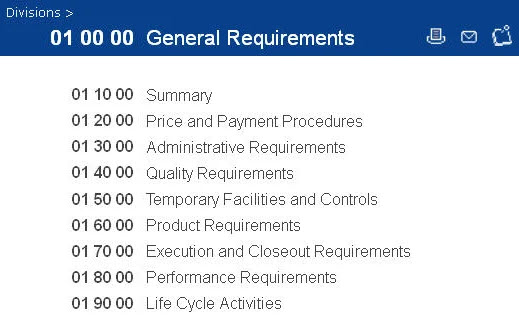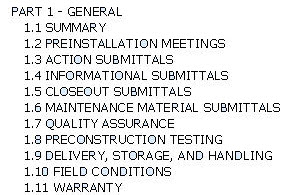Why the Architect/Engineer (A/E), of course!

CSI MasterFormat Division 01 Level 2 titles
courtesy of www.masterformat.com
You may like to think that. But what happens when a Construction Manager (CM) is involved in the project? Because the CM controls the subcontracts and assumes much of the construction site administrative and procedural requirements, the CM may want to control Division 01, too. When CMs insist on writing Division 01, should A/Es and Owners be paying attention? The answer must be YES, but what are the items of concern?
Division 01 - General Requirements set out the administrative and procedural rules for the entire project. Say it once, only once, and in the right place - an adage professed in CSI's Specifying Practice Guide. The same concept is promoted by the Uniform Location of Subject Matter (free download) that shows the primary and sometimes secondary locations for specifying virtually everything needed for a construction contract. When in doubt, ULSM is a handy reference about where subjects should be specified.
A Contractual Bridge
Division 01 forms the bridge between the Conditions of the Contract and the project specifications. The Conditions set out the overall duties and responsibilities of the Owner, Contractor, and A/E. Division 01 expands upon the Conditions of the Contract to explain how the contract will be administered and what procedures will be used to ensure an efficient (hopefully) construction process.
Compare Division 01 section titles and specification sections Part 1 - General article titles. The organization and content is parallel - for good reason. Part 1 specifies the administrative details for a particular specification. Each article relies on Division 01 for the related general requirements that apply to every specification in the Project Manual.
Coordination is Key
Before writing Division 01, it is imperative to know what will be used as basis for the A/E agreement, the construction agreement and the conditions of the contract. Industry standard agreements and conditions are available from AIA, EJCDC, ConsensusDocs, and other organizations. Some Owners, especially institutional owners maintaining multiple buildings, will have their own standard documents.
Why does this even matter? Well, Division 01 must be coordinated with the duties and responsibilities of the A/E, Owner, and Contractor required by their contracts. Writing Division 01 without knowing the contractual requirements will undoubtedly produce inconsistent, and perhaps conflicting, requirements. Construction contracts are complicated enough. Specifiers must be diligent about coordinating Division 01 to eliminate unnecessary confusion.
What to Watch
Here are some examples of the first things we look for when someone else writes Division 01. We try to ensure the A/E (our client), the CM, and the Owner (the one paying the bills) are aware of the potential impact.
Extended Responsibilities: Search every location where the A/E and Owner are named. Be certain the responsibilities being assigned are consistent with the Owner-A/E and the Owner-CM agreements. When writing Division 01, it is easy (for the CM or A/E) to pass responsibility to another. Be careful that Division 01 does not put the A/E or the Owner between the CM and the subcontractors for administering the contract.
Safety Requirements: CMs are concerned about their relationship with the subcontractors. These concerns include job-site safety. When written in Division 01, monitoring and enforcing safety requirements may be extended to A/Es who are required to administer the contract - including Division 01.
Allowances and Alternates: The description of each allowance and alternate, though controlled by the CM, must be carefully coordinated with the drawings and specifications. Otherwise, the pricing and contract may not reflect the complete design intent.
Definitions: Any definitions, beyond the terms defined by the construction agreement, could be potential trouble. Remember Division 01 applies to the entire project. If common terms such as furnish, install, and provide, among others, are defined, the entire design team must be sure to use the terms consistently throughout the drawings and specifications.
Time: CMs want to be sure A/E's responses are timely. Watch for unreasonably short times to respond to RFIs, submittals, progress payments, and project closeout. Be especially careful if there is no provision for the A/E to give notice of a particular condition that may require more time than specified such as reviewing all rebar drawings for a high rise concrete frame building received at the same time.
Submittals: Check the required transmission method. If the CM requires hardcopy, the A/E may be facing unexpected printing costs. Must the returned submittals be "Approved" before proceeding with construction? If the procedures do not allow "Approved as Noted," expect one additional review cycle for every submittal.
Substitutions: Is the A/E obligated to review multiple proposed products for each substitution request when the first one is rejected? Is every product eligible for a substitution request, even when specified as a proprietary item or with a closed product list?
Closeout: How many times must the A/E be willing to review and re-review the project to determine Substantial Completion and Final Completion? Additional reviews can require enormous amounts of time.
Too many times, there is a lackadaisical attitude about writing Division 01, despite the potential impact on the A/E, the Owner, and the Contractor's construction administration costs and liability exposure. We point out the pitfalls of what is written, when it is not our work, and coordinate the specifications to suit. That is really all a specifier can do.
A/Es, questioning the Division 01 content and coordinating the revisions to be consistent with your contracts is up to you.

